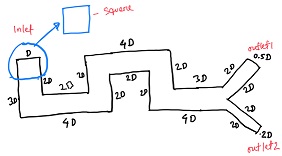Reference no: EM132647398
Advanced Flow Modelling
Objectives: To model and investigate using Computational Fluid Dynamics, the airflow and particle transport in a square bifurcating domain.
Apparatus: ANSYS Fluent will be used as currently available at UTS.
Problem: The overall dimensions of the square tube.

Fig 1: Schematic of the computational domain
The fluid flowing through the rectangular domain is air, with the following properties at 20 °C:
Air Density, r = 1.2 kg/m3
Dynamic viscosity, m = 1.81 x 10-5 Pa.s
Particle Size: 1-µm and 10- µm
Particle Density: 950 kg/m3
The boundary conditions for all the CFD models are:
Inlet Flow Rate = 15 lpm, 30 lpm (Optional), and 60 lpm
Outlet Pressure = Zero Pressure or Outflow outlet
Wall Boundary Condition = Reflect, Stationary Wall
Velocity at walls = 0 m/s (no slip)
Flow = Turbulent
Note: Particles will be injected through the inlet surface and all particles will be injected at once.
Procedure and discussion points:
1. Create the computational geometry in DesignModeler/ Solidwroks/any CAD software with the mentioned dimensions.
2. Build an appropriate mesh for the model. This will necessitate to run the simulations and make a grid refinement study presenting the results for different grids for 60 lpm flow rate.
3. Using the converged grid, check theiterative convergence for all flow rates.
4. Using the converged grid, run FLUENT for 15 lpm, 30 lpm, and 60 lpm flow rates.
5. Chart the axial velocity profiles u(y) at any three randomly selected positions for different flow rates and compare your results.
6. Discuss the turbulence intensity for different flow rates.
7. Plot the velocity streamline for all cases and discuss.
8. Plot the velocity contours for 60 lpm flow rate and discuss the flow characterization.
9. Show the particle trajectories at 60 lpm flow rate and discuss.
10. Calculate the wall shear for all cases and discuss.
11. Calculate the particle transport efficiency through the outlets and discuss.
12. Draw the particles pathline for 60 lpm and discuss.
13. Draw the velocity vectors for all flow rates and discuss.
14. Verify your results with the existing literature.